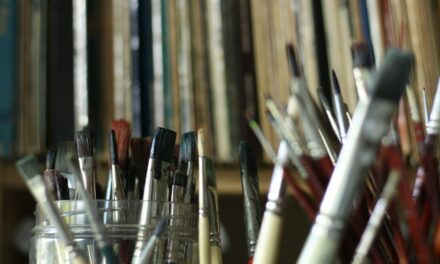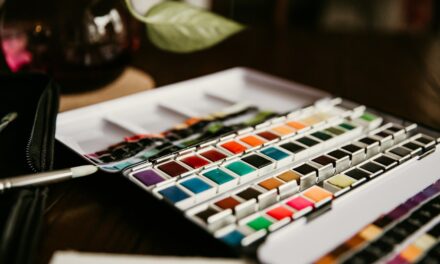Watercolor painting, with its ethereal washes and delicate hues, has captivated artists and art enthusiasts for centuries. This medium, known for its fluidity and transparency, allows for a unique interplay of light and colour that can evoke a range of emotions and atmospheres. Originating in ancient times, watercolour has evolved through various artistic movements, from the detailed botanical illustrations of the Renaissance to the expressive landscapes of the Impressionists.
Today, it remains a popular choice for both amateur and professional artists, offering a versatile platform for creativity. The charm of watercolour lies not only in its aesthetic appeal but also in its accessibility. With just a few basic materials, anyone can embark on their artistic journey.
The spontaneity of watercolour encourages experimentation, making it an ideal medium for those who wish to explore their artistic instincts. Whether capturing the subtle nuances of a sunset or the vibrant colours of a bustling market scene, watercolour painting invites artists to engage with their surroundings in a deeply personal way. As we delve into the world of watercolour, we will explore the essential materials, techniques, and tips that can help both beginners and seasoned artists alike to harness the beauty of this enchanting medium.
Summary
- Watercolor painting is a versatile and expressive medium that can produce beautiful and unique artworks.
- Understanding the different materials and tools used in watercolor painting is essential for beginners to create successful artworks.
- Basic watercolor techniques such as wet-on-wet, wet-on-dry, and dry brushing are fundamental for beginners to master.
- Colour mixing and palette organisation are important skills to learn in order to achieve the desired hues and tones in watercolor painting.
- Creating texture and effects with watercolor, such as lifting, splattering, and salt techniques, can add depth and interest to artworks.
Understanding Watercolor Materials and Tools
To embark on your watercolour journey, it is crucial to familiarise yourself with the essential materials and tools that will serve as your artistic arsenal. The primary components of watercolour painting include watercolour paints, brushes, paper, and palettes. Watercolour paints are available in various forms, including tubes and pans.
Tube paints tend to be more vibrant and are ideal for larger works, while pans are portable and convenient for sketching on the go. When selecting paints, it is advisable to invest in artist-grade quality, as they offer superior pigmentation and lightfastness compared to student-grade options. Equally important are the brushes you choose to work with.
Watercolour brushes come in various shapes and sizes, each designed for specific techniques. Round brushes are versatile and perfect for detail work, while flat brushes are excellent for washes and broader strokes. Additionally, consider using a mop brush for large areas or soft blending.
The type of paper you select also plays a significant role in your painting experience. Watercolour paper is typically heavier and more absorbent than standard paper, allowing it to withstand multiple washes without warping. Look for papers with a weight of at least 200 gsm (grams per square metre) for optimal results.
Basic Watercolor Techniques for Beginners
As you begin your exploration of watercolour painting, mastering a few fundamental techniques will set the foundation for your artistic development. One of the most essential techniques is the wet-on-wet method, where wet paint is applied to wet paper or wet paint. This technique allows colours to blend seamlessly, creating soft edges and beautiful gradients.
To achieve this effect, start by wetting your paper with clean water using a brush or a spray bottle before applying your chosen colours. Another vital technique is wet-on-dry, where wet paint is applied to dry paper. This method produces sharper edges and more defined shapes, making it ideal for creating details or layering colours.
Additionally, dry brushing is a technique that involves using a relatively dry brush to apply paint to dry paper, resulting in a textured effect that can add depth to your work. Practising these techniques will not only enhance your skills but also help you develop your unique style as you become more comfortable with the medium.
Colour Mixing and Palette Organisation
Understanding colour mixing is fundamental to achieving the desired hues in your watercolour paintings. Unlike other mediums, watercolours are transparent, meaning that layering colours can create stunning effects. Begin by familiarising yourself with the colour wheel and the relationships between primary, secondary, and tertiary colours.
Mixing complementary colours can produce muted tones, while analogous colours can create harmonious blends.
A well-arranged palette allows you to access colours quickly and facilitates mixing.
Consider grouping colours by hue or temperature—warm colours on one side and cool colours on the other. Additionally, leave space for mixing new shades; this will encourage experimentation and help you discover unique colour combinations that resonate with your artistic vision.
Creating Texture and Effects with Watercolor
One of the most captivating aspects of watercolour painting is its ability to create texture and effects that can enhance your artwork significantly.
For instance, sprinkling salt onto wet paint creates a beautiful crystalline effect as it absorbs moisture from the paint.
Similarly, sponging can add an organic texture that mimics natural elements like foliage or clouds. Another effective method for creating texture is layering washes. By applying multiple layers of transparent colour, you can build depth and complexity in your work.
Experimenting with different brush strokes can also yield interesting results; for example, using a fan brush can create fine lines that resemble grass or fur. Embracing these techniques will not only enrich your paintings but also allow you to express your creativity in new and exciting ways.
Tips and Tricks for Successful Watercolor Painting
Working from Light to Dark
Firstly, always remember to work from light to dark; this approach allows you to maintain the luminosity of your painting while building depth gradually. Start with lighter washes and progressively add darker tones as needed.
Embracing Mistakes and Experimentation
This technique is particularly effective in creating dimension and ensuring that your highlights remain vibrant. Additionally, don’t be afraid to embrace mistakes; they often lead to unexpected discoveries in your artwork. Watercolour is inherently unpredictable due to its fluid nature, so allow yourself the freedom to experiment without fear of failure.
Practising and Refining Your Technique
Keep a sketchbook handy for practice; this will enable you to try out new techniques or colour combinations without the pressure of creating a finished piece. Lastly, take breaks during your painting sessions; stepping back from your work allows you to gain perspective and assess areas that may need adjustment.
Common Mistakes to Avoid in Watercolor Painting
While watercolour painting can be an enjoyable experience, there are common pitfalls that beginners often encounter. One frequent mistake is overworking the paint; excessive layering or scrubbing can lead to muddy colours and loss of vibrancy. To avoid this issue, allow each layer to dry before adding more paint or details.
This practice not only preserves the integrity of your colours but also helps maintain the transparency that characterises watercolour. Another common error is neglecting the importance of planning your composition before diving into painting. Taking time to sketch out your ideas or create a value study can provide clarity and direction for your final piece.
Additionally, be mindful of your water usage; too much water can dilute your pigments excessively, while too little can lead to harsh lines and uneven washes. Striking a balance between water and pigment is key to achieving the desired effects in your artwork.
Resources for Further Learning and Inspiration
As you continue on your watercolour journey, numerous resources are available to further enhance your skills and inspire creativity. Online platforms such as YouTube offer countless tutorials from experienced artists who share their techniques and insights into watercolour painting. Websites like Skillshare or Udemy provide structured courses that cater to various skill levels, allowing you to learn at your own pace.
Books on watercolour techniques can also be invaluable resources; titles such as “Watercolor Painting: A Complete Guide” by John Hulsey or “The Watercolor Artist’s Guide” by David Dewey offer comprehensive insights into both foundational skills and advanced techniques. Additionally, visiting art galleries or exhibitions featuring watercolour works can provide inspiration and insight into how different artists approach this medium. Engaging with local art communities or workshops can also foster connections with fellow artists who share your passion for watercolour painting.
In conclusion, watercolour painting is a captivating medium that offers endless possibilities for artistic expression. By understanding the materials and techniques involved, embracing experimentation, and learning from both successes and mistakes, you can unlock your creative potential within this enchanting art form. Whether you are a beginner or an experienced artist seeking new inspiration, the world of watercolour awaits you with open arms.
If you are interested in exploring the world of art beyond watercolor painting, you may want to check out The Visual Storyteller. This article delves into the power of visual storytelling and how artists can effectively communicate their narratives through their work. It offers valuable insights into the creative process and the impact of visual art on society. Whether you are a newcomer to the art world or a seasoned artist, this article is sure to inspire and inform your artistic journey.



